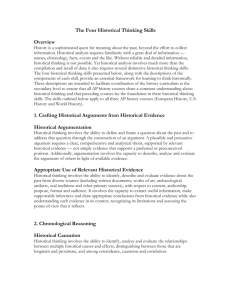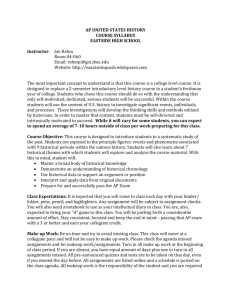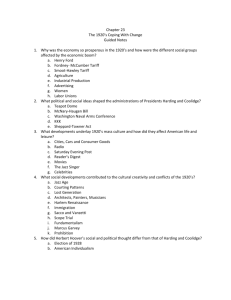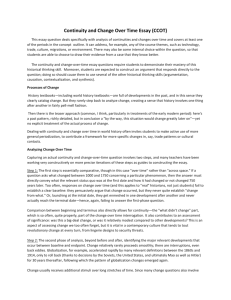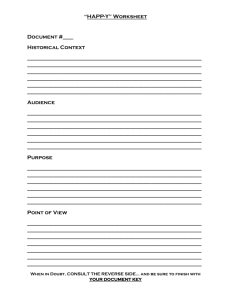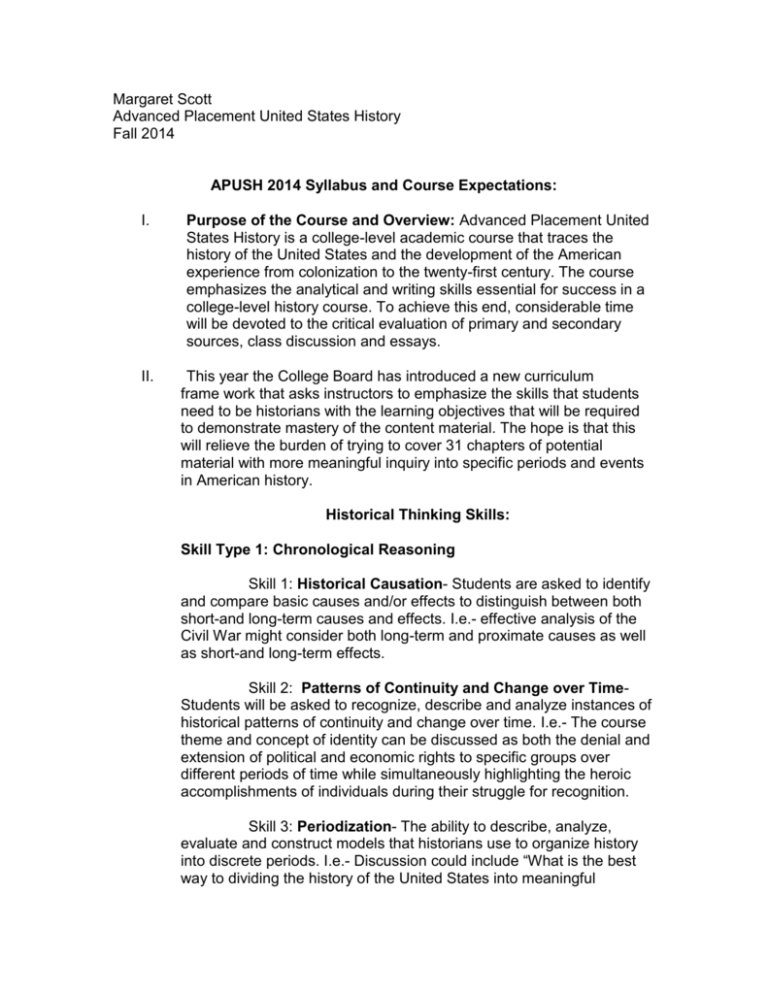
Margaret Scott
Advanced Placement United States History
Fall 2014
APUSH 2014 Syllabus and Course Expectations:
I.
II.
Purpose of the Course and Overview: Advanced Placement United
States History is a college-level academic course that traces the
history of the United States and the development of the American
experience from colonization to the twenty-first century. The course
emphasizes the analytical and writing skills essential for success in a
college-level history course. To achieve this end, considerable time
will be devoted to the critical evaluation of primary and secondary
sources, class discussion and essays.
This year the College Board has introduced a new curriculum
frame work that asks instructors to emphasize the skills that students
need to be historians with the learning objectives that will be required
to demonstrate mastery of the content material. The hope is that this
will relieve the burden of trying to cover 31 chapters of potential
material with more meaningful inquiry into specific periods and events
in American history.
Historical Thinking Skills:
Skill Type 1: Chronological Reasoning
Skill 1: Historical Causation- Students are asked to identify
and compare basic causes and/or effects to distinguish between both
short-and long-term causes and effects. I.e.- effective analysis of the
Civil War might consider both long-term and proximate causes as well
as short-and long-term effects.
Skill 2: Patterns of Continuity and Change over TimeStudents will be asked to recognize, describe and analyze instances of
historical patterns of continuity and change over time. I.e.- The course
theme and concept of identity can be discussed as both the denial and
extension of political and economic rights to specific groups over
different periods of time while simultaneously highlighting the heroic
accomplishments of individuals during their struggle for recognition.
Skill 3: Periodization- The ability to describe, analyze,
evaluate and construct models that historians use to organize history
into discrete periods. I.e.- Discussion could include “What is the best
way to dividing the history of the United States into meaningful
periods? What are the consequences of choosing one set of dates for
a particular movement instead of another time frame? “
Comparison and Contextualization:
Skill 4: Comparison- Students will be asked to compare
related historical developments and processes across place, time, or
different societies (or within one). A comparison example might be
“How similar or different were the periods of US expansion or how
does “conservatism” compare in the 1920s, 1950s and 1980s? “
Students could also compare thematic developments in different time
periods, such as how environmental attitudes and policies in the first
decade of the 20th century compare with those in the last decade of
that century, or the comparative impact of migrations to the US in the
1890s and the 1980s.
Skill 5: Contextualization- This skill asks students to
recognize and explain ways in which historical phenomena or
processes connect to broader regional, national or global processes.
How does the history of a particular group, region or era fit into the
larger story of the development of the United States? Students could
look at the interaction between watershed events like Reconstruction
and the later civil rights movement.
Skill 6: Historical Argumentation- Students will be asked to
be able to describe commonly accepted historical arguments about the
nature of the past and then explain how such arguments have been
constructed from historical evidence. I.e.- Connecting the themes of
politics and power, students might be asked to examine evidence and
construct an argument about the causes of the Civil War.
Skill 7: Appropriate Use of Relevant Historical EvidenceThis skill asks students to analyze documents for one or more of the
following features: audience, purpose, point of view, format, argument,
limitations and context important to the historical evidence considered.
I.e.- archeological and geographical evidence might be other things to
consider during analysis.
Skill 8: Interpretation-Students will create their own
interpretation of U.S. history; interpretations should be evaluated over
time. This will also introduce the idea of “presentism” where modern
perspectives are introduced into historically significant events. An
example might be looking at how interpretations of American slavery or
Reconstruction have changed.
Skill 9: Synthesis- Students demonstrate an understanding
of the past by making an argument that draws appropriately on ideas
from different fields of inquiry or disciplines when presented to them in
the form of data and/or arguments.
Thematic Learning Objectives- topics of historical inquiry to
explore throughout the APUSH course:
All questions on the AP exam will measure student understanding of the
specified thematic learning objectives listed below.
IDENTITY-Students should be able to explain how these sub- identities
have interacted with each other and with larger conceptions of American
national identity.
Overarching Questions:
1. How and why have debates over American national identity changed
over time?
2. How have gender, class, ethnic, religious, regional and other group
identities changed in different eras?
WORK, EXCHANGE AND TECHNOLOGY- Students should explore the
lives of working people and the relationships among social classes, racial,
ethnic groups and men and women including the availability of land and
labor, national and international economic developments and the role of
government support and regulation.
1. How have changes in markets, transportation and technology
affected American society from colonial times to the present day?
2. Why have different labor systems developed in British North America
and the U.S., and how have they affected U.S. society?
3. How have debates over economic values and the role of government
in the U.S. economy affected politics, society, the economy and the
environment?
PEOPLING- Students explore the ideas, beliefs, traditions, technologies,
religions and gender roles that migrants/immigrants and annexed peoples
brought with them and the impact these factors had on both these peoples
and on U.S. society.
1. Why have people migrated to, from and within North America?
2. How have changes in migration and population patterns changed or
affected American life?
POLITICS AND POWER- Students trace efforts to define or gain access
to individual rights and citizenship and survey the evolutions of tensions
between liberty and authority in different periods of U.S. history.
1. How and why have different political and social groups competed for
influence over society and government in what would become the
United States?
2. How have Americans agreed on or argued over the values that guide
the political system as well as who is a part of the political process?
AMERICA IN THE WORLD- Students should also investigate how
American foreign policies and military actions have affected the rest of the
world as well as social issues within the United States itself.
1. How have events in North America and the United States related to
contemporary developments in the rest of the world?
2. How have different factors influenced U.S. military, diplomatic and
economic involvement in international affairs and foreign conflicts,
both in North America and overseas?
ENVIRONMENT AND GEOGRAPHY-PHYSICAL AND HUMANStudents should analyze the interactions between the environment and
Americans in their efforts to survive and thrive. Students should also
explore efforts to interpret, preserve, manage or exploit natural and manmade environments, as well as the historical contexts within which
interactions with the environment have taken place.
1. How did interactions with the natural environment shape the
institutions and values of various groups living on the North
American conflict?
2. How did economic and demographic changes affect the environment
and lead to debates over use and control of the environment and
natural resources?
IDEAS, BELIEFS AND CULTURE-Students will analyze the interactions
between beliefs and communities, economic values and political
movements, including attempts to change American society to align it with
specific ideals.
1. How and why have moral, philosophical and cultural values changed
in what would become the United States?
2. How and why have changes in moral, philosophical and cultural
values affected U.S. history?
HISTORICAL PERIODSThere are 9 historical periods encompassed in the exam. These historical
periods will accompany the learning objectives and skills as the basics for the AP
exam. Below are the rough estimates of where the emphasis will be and
accordingly how much time should be devoted to that particular period’s material.
Approximate Percentage of…
Instructional Time
AP Exam
Period
Date Range
1
1491-1607
5%
2
3
4
5
1607- 1754
1754-1800
1800-1848
1844-1877
10%
12%
10%
13%
6
7
8
1865-1898
1890-1945
1945-1980
13%
17%
15%
45%
5%
5%
9
1980-Present
5%
45%
Textbook:
Faragher, John Mack, Mari Jo Buhle, Danile Czitrom, and Susan H. Armitage.
Out of Many: A History of the American People, AP Edition, 6th edition. Upper
Saddle River, New Jersey: Pearson Prentice Hall, 2006.
Assessment and Grading Scale:
Student achievement in the class will be assessed in five areas:
Exams…………………………………………30%
Quizzes……………………………………….20%
DBQ and Free Response Essays………….30%
Classwork…………………………………….10%
Homework……………………………………10%
Exams will consist of multiple-choice questions formatted similar to those on the
AP exam. Some exams will be cumulative meaning previous material could be
seen again. This is designed to reinforce material and facilitate the discovery of
connections and comparisons with the content.
Being able to analyze documents and develop a logical written argument is a skill
essential for success on the AP exam but also in college. Topics for our assigned
DBQ and free response essays will follow the AP format and emphasize material
addressed in class. The AP grading rubric will be used to evaluate each piece of
writing for the Document-Based Question and Free Response.
Classroom Expectations:
1. The textbook, notebook and pen or pencil must be brought daily. Success in
AP depends in part of the student’s self-discipline and work ethic. Good
attendance is crucial! Being prepped for class, taking notes and contributing to
the discussion are explicit expressions of those essential characteristics. It is also
an expression of respect for the class, the subject and the instructor.
2. Make-up tests are to be taken AFTER-SCHOOL or during a STUDY HALL.
3. If you are absent the day an assignment is due, the expectation is that it is
emailed in to me the same day, if there is a test or quiz the expectation is that
you take it upon return. For longer absences, you will be given the requisite
number of days to complete the assignment, as you were absent- 3 days out, 3
days to make it up. Extenuating circumstances do present and will be considered
if necessary.
4. PLEASE USE THE RESTROOM AT THE VERY START OF CLASS OR END.
5. Use of technology- this will be in flux this year as we start the one- to- one
initiative but use the tech appropriately and your time wisely
6. It is also my expectation that you take the AP exam in May; I want you to
receive college credit. I also appreciate getting the feedback about how I am in
doing with preparing my students to take the exam. Do us both a favor? If your
college accepts the AP score- take the test!
Homework and Articles Assignment:
There will RARELY be a day when the student does not have homework in AP
U.S. Expect daily reading assignments, taking notes or reviewing class materials.
Reading assignments by unit will be broken out in advance and given in handout
form or posted on my webpage. If you do not like to read or lack motivation,
sadly, this course may not be for you. I will not change the rigor or expectations if
you contract senioritis and I have had students fail marking periods of APUSH in
the past. We should not have to worry about you graduating because you’ve
chosen to take my class!
Course Planning and Pacing by Unit:
UNIT 1- 1491-1607:
Historical Synthesis, DBQ Analysis, Presidential Chunking and varied Precolonial Native American cultures
Some introductory activities like the APPARTs structure, DBQ analysis to
determine what scorers and I will look for in upcoming DBQ and free response
questions and a collaborative activity designed to have students commit to
memory our nation’s presidents, their political party and at least one memorable
event in each presidency. “An Aztec account of the Conquest of Mexico”, Burying
the White Gods: New Perspectives on the Conquest of Mexico” by Camilla
Townsend.
Skills and Learning Objectives Addressed: (Interpretation, Comparison, PEO-1,
ENV 1 & 2) Length: App. 9 Days
UNIT 2- 1607-1754:
This unit will focus upon the diversity of settlement among the English and the
expansion of settlement in North America. Demographic change will be
addressed as African Americans replace indentured servants as a labor source.
Comparisons of southern, middle and northern colonies will be evaluated.
Primary sources that will be utilized are the following: “Ann Putnam’s
Deposition and Confession”, “Mayflower Compact”, “William Penn’s Description
of PA”, and “VA Law on Indentured Servitude.” Other sources used: “Anne
Hutchinson is Banished (1637)”, “Cotton Mather on the Virtuous Woman, 1698”
“Entertaining Satan Witchcraft and the Culture of Early New England”. Selections
from James Axtell, ed., “Indian Peoples of Eastern America: A Documentary
History of the Sexes” and “The Rhythms of Labor: African American Women in
Colonial Society.” “Sinners in the Hands of an Angry God” by Jonathon Edwards
and James Oglethorpe’s “Establishing the Colony of Georgia.” Chapters 2-5 Out
of Many, Faragher, et al.
Skills and Learning Objectives addressed: (Appropriate Use of Relevant
Historical Evidence, Interpretation, Contextualization, Comparison, Patterns of
Continuity and Change over Time, ID-4, ID-6, WXT-4 & 5, PEO-1, PEO-4, POL1, WOR-1, ENV-1, ENV-4, CUL-1, CUL-4) Length: Approximately 14 days
Unit 3: 1754-1800
British imperial attempts to reassert control over its colonies and the colonial
reaction to these attempts produced a new American republic, along with
struggles over the new nation’s social, political and economic identity.
Primary sources that will be used are the following: “Albany Plan of the
Union”, “Join or Die “political cartoon, “Common Sense”, “Remember the Ladies”
letter, Paul Revere’s engraving, Townsend Acts, Stamp Act. “Give Me Liberty or
Give Me Death,” Patrick Henry, Boston Gazette’s Description of the Boston
Massacre, 1770; Dickinson’s “Letters from a Farmer in Pennsylvania” and James
Otis, “The Rights of the British Colonies Asserted and Proved.” Joseph Warren’s
“Account of the Battle of Lexington” and Jefferson’s rough draft of the Declaration
of Independence. We will also be evaluating the differences between the Articles
of Confederation and the Constitution, James Madison’s “The Virginia Plan,”
Alexander Hamilton’s “An Opinion on the Constitutionality of an Act to Establish a
Bank” and the Bill of Rights. Students will also use Out of Many, Faragher, and
et.al chapters 6-8.
Skills and Learning Objectives Addressed: Historical Causation,
Periodization, Comparison, Historical Argumentation, Interpretation, ID-1, ID-5,
WXT-4, WXT-6, POL-2, POL-5, ENV-2, Env-3 and CUL-2. Length: 17 days
Unit 4: 1800-1848:
The new republic struggled to define and extend democratic ideals in the face of
rapid economic, territorial and demographic changes.
Primary Sources that will be used include the following: “Davy Crockett’s
Advice to Politicians”, “Washington’s Farewell Address”, “Jackson’s inaugural
address”, “Treaty of Ghent”, “Lewis and Clark meet the Shoshone”,
“Constitutionality of the Louisiana Purchase,” “Star Spangled Banner” and
“Federalist #10 and #54. “The Confession of Nat Turner” is another source that
will be used as well as various slave advertisements. “Compromise of 1820”,
excerpts of De Tocqueville’s “Democracy in America”, “Treaty with the Sioux and
other Tribes, 1825” and “Jackson’s Veto of the Bank Bill.” “Hodgdon Family
Letters Regarding Life in the Mills”, Catherine Beecher, from a “Treatise on
Domestic Economy” and Charles Finney, “What a Revival of Religion Is.”
Students will also use Out of Many chapters 9-12.
Skills and Learning Objectives Addressed: (Historical Causation, Patterns of
Continuity and Change over Time, Periodization, Comparison, Contextualization,
Interpretation, ID-2, ID-4, WXT-2, WXT-5, PEO-2, POL-3, WOR-2, ENV-3, CUL2, CUL-5)
Anticipated Length: approximately 12 days
Unit 5: 1844-1877:
As the nation expanded and its population grew, regional tensions, especially
over slavery, led to civil war—the course and aftermath of which transformed
American society.
Primary Sources that will be used are the following: “Emancipation
Proclamation”, “Gettysburg Address”, Olmstead “Freedmen to Master”, LincolnDouglas Debates, Oliver Wendell Holmes “Old Ironsides”, “House Divided
Speech”, parts of Uncle Tom’s Cabin, “Causes of Secession”, “Garrison’s
position on John Brown’s Raid,” “John L. O’Sullivan’s “The Great Nation of
Futurity”, “James K. Polk’s inaugural address” and Chief Joseph’s “My Son, Stop
Your Ears.” Accounts of soldiers who participated in Antietam, Chancellorsville
and Gettysburg will be used. Henry Clay’s Compromise of 1850 transcript will be
utilized as well as Northern and Southern perspectives on the quality of the
compromise. Taney’s opinion in the Dred Scott case will be evaluated as well as
a reading of the Reconstruction amendments: 13, 14 and 15. The Compromise of
1877 is an appropriate place to curtail this unit in the form of a debate. Out of
Many, Faragher, et.al. will be used: chapters 13- 18
Skills and learning objectives addressed: (Historical Causation, Periodization,
Comparison, Contextualization, Historical Argumentation, Interpretation,
Synthesis, ID-2 & 6, WXT-2, WXT-6, PEO-5, POL-3 & 6, WOR-5, ENV-3 and
CUL-3)
Length: Approximately 21 days
Unit 6: 1865-1898
Multiple reconstruction plans were introduced and those reflect the divergent
thinking of how severely the south should be punished for their secession. Freed
blacks will move to find economic opportunity stressing the north but also
opening up the west to growth. The significance of the influx of immigrants and
their impact on cities in America will be evaluated as well. The transformation of
the United States from an agricultural to an increasingly industrialized and
urbanized society brought about significant economic, political, diplomatic, social,
environmental and cultural changes.
Primary Sources that will be used are the following: sharecropper contract,
“Mississippi Black codes”, Worse than slavery- Nast cartoon, Nast cartoons on
Boss Tweed, photo of Union Pacific and Central Pacific Link @ Promontory
Point. “Slumming Among the Unemployed: William Wyckoff’s study of
Joblessness in the 1890s”, Bryant’s “Cross of Gold” Speech: Mesmerizing the
Masses”, excerpts from Red Cloud’s “Speech at Cooper Union, New York, July
16th 1870”, Sand Creek Massacre Accounts, Wounded Knee perspectives as
well as accounts of the Battle of Little Bighorn. Also incorporated will be excerpts
from Andrew Carnegie’s The Gospel of Wealth, Horace Greeley, “from an
Overland Journey”, Helen Hunt Jackson, from A Century of Dishonor and John
Muir, The Yosemite.
To highlight immigrant experience: Chinese Exclusion Act, 1882, “Gentlemen’s
Agreement” and Lee Chew’s “Experiences of a Chinese Immigrant, 1903.”
Students will also use the Out of Many text chapters 18-20.
Skills and Learning Objectives Addressed: (Historical Causation, Patterns of
Continuity and Change, Periodization, Comparison, Contextualization, Historical
Argumentation, Interpretation, Synthesis, ID-3, WXT-3 & 5, PEO-2, PEO-6, POL6, WOR- 4 & 6, ENV-5, CUL-6)
Approximate Length: 21 days
Unit 7: 1890-1945
An increasingly pluralistic U.S. faced profound domestic and global challenges,
debated the proper degree of government activism, and sought to define its
international role. Imperialism and world war will lead Americans to question
whether global expansion is a helpmate or hindrance to the “American Dream”.
Ethnic diversity will become more apparent during these big years of immigration.
Domestic reform sponsored by the Progressive Movement will be examined, as
will American attitudes toward involvement in WWI and WWII.
Primary sources used include the following: “Mahan’s interest in America as
a Sea Power”, “Platt Amendment”, William Jennings Bryant ‘s “Cross of Gold
Speech”, “Treaty of Versailles,” Margaret Sanger’s “1920 Declaration of
Sentiments”, “The Hayseed”, excerpt from The Jungle, “Migrant Mother” photo.
Jacob Riis photographs, excerpts from The Shame of the Cities, Theodore
Roosevelt, “The Strenuous Life” and “The New Nationalism.” Wilson’s “The New
Freedom” and “Fourteen Points.” Also referred to “Honest Graft”, George
Washington Plunkett, William Howard Taft’s “Dollar Diplomacy”, Volstead Act,
Eugene Kennedy’s “Diary Passages Describing Life at the Front” and A.Mitchell
Palmer’s “On the Menace of Communism.” 1920s advertisements will be
evaluated, “Creed of Klanswomen”, Court Statements Nicola Sacco and
Bartolommeo Vanzetti, 1927; Herbert Hoover’s New York Campaign Speech
from 1932, “Share Our Wealth”, Huey Long, Fireside chat examples and
Executive Order 9066 from 1942. The court case Korematsu v. U.S. deserves
attention, as does Truman’s Statement on the Atom Bomb in 1945. Out of Many
chapters 18-25 will serve as further guide thru this unit for students.
Skills and Learning Objectives Addressed: (Historical Causation, Patterns of
Continuity and Change, Periodization, Contextualization, Historical
Argumentation, Appropriate Use of Relevant Historical Evidence, Interpretation,
ID-3 & 8, WXT-7, PEO-6, POL-4 & 7, WOR-4 & 7, CUL-7)
Approximate Length: 28 days
Unit 8: 1945-1980
The short years between the end of WWII and the Korean War followed
immediately by Vietnam demonstrate conflicting sentiments in the United States.
Protests by Civil Rights protestors, students and workers effectively shows the
diverse opinions held by the American people at this time in history. The role of
America as a world leader in the post-WWII world will be evaluated. Domestic
programs and foreign policies of the Kennedy, Johnson and Nixon
administrations will be reviewed. This period demonstrates that the United States
had to grapple with prosperity and new international responsibilities while living
up to American ideals.
The following documents will be used: “Marshall Plan”, “Truman Doctrine”,
“1965 Voting Rights Act”, excerpt from “Feminine Mystique”, Joseph Welch’s
McCarthy letter, Dewey Defeats Truman misprint, “Iron Curtain” speech, Lyrics of
“Strange Fruit”, “Letters from a Birmingham Jail”, My Lai testimony, Roe v. Wade
verdict, “Brown v. Board of Education.” Ladies Home Journal, “Young Mother”,
“The Teenage Consumer”, Jack Kerouac’s, “On the Road”; John Lewis, “Address
at the March on Washington,” “Voting Literacy Test” and Executive Order 10730:
Desegregation of Central High School. House Judiciary Committee’s
Assessment of Nixon’s Activities will be used during this unit as will “Johnson’s
Defense of the U.S. Presence in Vietnam”, Gay Liberation Front, 1970; Cesar
Chavez, “He Showed Us the Way”; and Shirley Chisholm, “Equal Rights for
Women. Jimmy Carter’s “The ‘Crisis of Confidence’ Speech (1979), “The SupplySide Revolution” by Paul Robert Craig will be referenced and Reagan’s First
Inaugural Address will be reviewed.
Skills and Learning Objectives Addressed: (Historical Causation, Patterns of
Continuity and Change over Time, Periodization, Comparison, Contextualization,
Historical Argumentation, Synthesis, ID-3, ID-8, WXT-8, PEO-7, POL-7, WOR-8
and CUL-7)
Approximate length: 24 days
Unit 9: 1980-Present
Students will characterize society under Ronald Reagan and George H. Bush’s
administrations. Clinton and George W. Bush’s domestic and foreign policies will
be discussed as will issues that the United States is currently facing. Human
rights, globalization and societal change are themes integral to this unit. As the
United States transitioned to a new century filled with challenges and
possibilities, it experienced renewed ideological and cultural debates, sought to
redefine its foreign policy, and adapted to economic globalization and
revolutionary changes in science and technology.
The following documents will be used in this unit: “No Child Left Behind”,
Clinton’s Impeachment Trial transcripts, Patriot Act, NAFTA, SU Collapse news
release. We will also incorporate George W. Bush’s Address to Congress,
(2001), the Affordable Care Act and excerpts from Jesse Jackson’s Common
Ground, (1988).
Skills and Learning Objectives: (Historical Causation, Patterns of Continuity
and Change over Time, Historical Argumentation, Interpretation, Synthesis, ID-8,
WXT-8, PEO-7, POL-7, WOR-8, ENV-5, CUL-7)
Approximate Length: 7 Days
This allows for approximately 2 weeks of review before the AP exam. The
schedule found above is tentative and may be tweaked or changed a bit to
allow for course disruptions, weather interruptions, etc. All efforts will be
made to give students maximum notice if changes need to be made.
I am available for help or review during ________ period. Please take advantage
of the time for assistance and ask questions early and often.
Mrs. Scott’s email is mscott@pgsd.org. On evenings before exams and quizzes,
I will make all attempts to check email at the end of the evening just in case there
are some last minute questions or clarifications needed. Before midterms and the
AP exam, I am also very open to holding optional review sessions in the
afternoon or evening. Therefore, your success really hinges on your willingness
to advocate for yourself not just your ability. I hope that you have a great senior
year and look forward to the learning we will all do this year in AP! Think of me as
being here to simply give you A-PUSH!
Best,
Mrs. Scott

